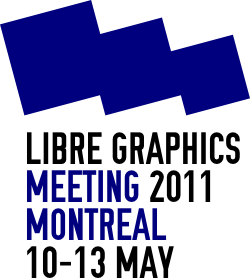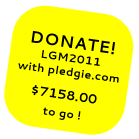Day 4
Friday May 13 2011
09:00
Better and faster image resizing and resampling
Nicolas Robidoux
http://
Regular talk in the form of a series of linked lightning talks. We would of course like some time for questions. Could eat up a one hour block with 5 min Q&A after each 5 min talk? (This would mesh better with RiverTV than having all the questions at the end? We’d love feedback and discussion: Much of this is work in progress.
* Jinc-windowed Jinc clamped Elliptical Weighted Averaging: A superior alternative to Lanczos Sinc-windowed Sinc filtering
Several improvements to Heckbert’s EWA method have produced a filter with the desirable features of the classical Lanczos filters. The method, suitable for demand-driven systems (GEGL, VIPS…) will be described, its strenghts and weaknesses stated, and comparative results involving image enlargement and reduction, computed with the ImageMagick implementation, will be shown. (Presenter: NR. Authors: NR, ATh, FW and CR.)
* High quality automated JPEG thumbnail and reduced image production with adaptive prefiltering
JPEG is still the format of choice for the electronic transmission of small and full size versions of natural images. At low quality levels, however, its block and ringing artifacts reduce its edge over JPEG2000 and dithered PNG8. These artifacts can be reduced by increasing the strength the lowpass filter used to reduce the size of the image. ImageMagick examples, illustrating these and other ways of maximizing bang for the buck, will be discussed. (Presenter: NR. Authors: NR and FW.)
* Nohalo subdivision with Locally Bounded Bicubic finish: A halo free upsampling method
LBB-Nohalo is a novel halo-free resampling method which can be roughtly described as an adaptive blend of Hermite and Catmull-Rom interpolation. The method, suitable for demand-driven systems, will be described, its strenghts and weaknesses stated, and comparative results involving image enlargement, computed with the VIPS implementation, will be shown. (Presenter: NR. Authors: NR, CR, JC and ATu.)
* Jacobian adaptivity: How to smoothly blend a resampling method tuned for upsampling with one tuned for downsampling
Suppose that you have a favorite sampler tuned for upsampling, and a favorite sampler tuned for downsampling. How do you “”blend”" them so that the “”right”" one is used, yet without “”switching”" artifacts when warping goes from up- to downsampling within an image (as can happen when performing a perspective transformation) or in different directions at a single point (like when resizing by making the width smaller but the hight larger)? Answer: Blend depending to the singular values of the Jacobian of the transformation at the point under consideration. Details will be provided, and GEGL results hopefully shown (still coding! the machinery is built into GEGL but no high quality sampler currently uses it). (Presenter: ATu. Authors: NR, ATu, CR and others.)
* The hacker’s guide to the computation of common resampling filters and related geometrical quantities
Several simple but little known formulaic simplifications for common filters (bilinear, Catmull-Rom, Blackman, …) leading to speedups will be presented. Most have already been implemented in ImageMagick and VIPS. In some cases, calling them directly is faster (and more accurate) than using Look Up Tables. Another example of simplification: Highly efficient trig.-free computation of the smallest ellipse containing both the image of a disk by an linear tranformation and the disk itself, and computation of the containing parallelogram with horizontal top and bottom sides. (Presenters: NR and CR. Authors: NR, JC, ATh and CR.)
* Highly accurate polynomial approximation of windowed-Sinc and windowed-Jinc filter kernels
The Boost C++ minimax package can be used to produce fast and highly accurate polynomial approximations of non-polynomial filter kernels. Examples involving both the Sine and Bessel versions of Lanczos 2 and Lanczos 3 will be given. Similar approximations are used by ImageMagick. (Presenter: CR. Authors: NR, CR and ATh.)
MyPaint – the past, the present, and the future
Jon Nordby
http://www.jonnor.com
MyPaint is a fast and easy open-source graphics application for digital painters that lets you focus on the art instead of the program. Started in 2004 by Martin Renold to be a painting program he enjoyed to use and develop, MyPaint has grown to become a popular Libre Graphics tool.
This talk will guide you through the past, present and future of MyPaint:
Past A quick look at the history of MyPaint; the initial idea/motivation, and some of the significant events.
PresentAn overview of the current status of MyPaint; what has happened in the last months and what is happening right now. A central part here will be about the MyPaint 1.0 release.
Future Discussion about the future of MyPaint; some of the concrete plans that exist, and more abstract/undecided ideas and visions. Last but not least, how you can help the future of MyPaint will be covered.
The talk will be introductionary in nature, and not especially technical. Curious digital artists, existing end-users, potential and existing contributors should all find this talk interesting.
10:00
Quick and Dirty Usability: Leveraging Google Suggest to Instantly Know Your Users
Michael Terry
http://hci.uwaterloo.ca/research/query_log_analysis
Every second of every day, people use Google to troubleshoot problems and to learn how to accomplish their goals. While Google doesn’t make its search query logs publicly available, Google Suggest can be used to learn the most popular queries for any software.
We systematically mined all of the query suggestions for GIMP, Inkscape, Blender, and Scribus to learn about the primary needs and problems encountered by users of these software applications. As examples, our technique collected ~15,000 common queries for GIMP and ~2500 queries for Inkscape.
In this talk, we will present samples of the most common search queries for these applications, and what they suggest about the software user bases and their needs.
10:30
Towards an Document Object Model (DOM) for Scribus
Andreas Vox
http://www.scribus.net
A Document Object Model serves more than one goal. Apart from storing the document’s data, it also supports scripting and serialization. It’s also the backbone for talking about compatibility, extensibility and testing.
In this talk I’ll propose to use Relax NG for describing a new Scribus file format that also serves as DOM. With some tools, design patterns and Qt’s metaobject framework it will be possible to generate a DOM that maps 1:1 to the new file format and is accessible to scripts.
10:45
Toonloop: animation for live performances
Alexandre Quessy
http://toonloop.com/
In this technical talk, the main author of Toonloop will describe how this free software works and why it has been designed with simplicity in mind. It displays image loops, and allows to apply GLSL shader effects on them. The use of the Clutter toolkit makes it possible to create rich user interfaces that are well suited for fullscreen video in the context of live performances and artistic installations. Thanks
to GStreamer, Toonloop could grow and upport more operating system and video input types. Also, OSC and MIDI controls make the
application open to new possibilities for interactive setups.
11:00
Open Publishing with PressBooks
Hugh McGuire & Christine Prefontaine
http://pressbooks.com/
PressBooks
platform built on WordPress that makes it easy for you and your team to
write, edit, and generate clean, well-formatted books in multiple outputs:
epub, print-ready PDF, layout-ready XML, and HTML. Hugh will provide an
overview of the PressBooks project and Christine will demo how the
University of Washington’s Technology & Social Change
texts.
14:00
Scribus, O.I.F. branch
Jean Ghali
http://www.scribus.net
A new branch as a new experience for Scribus. Between UI redesign, core components rewriting and team meeting, something happened.
14:30
Introducing AdaptableGIMP
We will describe the rationale behind the approach, demonstrate the new interface and its features, and discuss implications for this design.
15:00
Free Graphics Programming, experiences & thoughts
Pierre Marchand
http://oep-h.com
A year at programming for graphic|product design with free softwares and freedom in mind.
16:00
The Natural Economics of Open Source
Colin Vernon
http://stresslim.it/
Free software is great and all, but how does this “work”? Reflections on the economic water level — commerce, ideals and practicalities at different scales. Colin is a long-time web programmer and partner at stresslim.it a Montreal-based web development company.
16:20
In situ animation with Toonloop
http://toonloop.com/
In this presentation, Alexandre Quessy will present and demonstrate Toonloop, the live animation software. Participants will be able to
try it with a camera and some lighting. He will explain why he created Toonloop, and how many people experimented with it for making movies, performances, installations as well as for teaching frame by frame animation. Stop motion can also be used for creating quick mockups of user interfaces.
Toonloop is a free software frame by frame animation application. Creating an animation with Toonloop is very easy, since the current
clip is constantly played back while being edited. This constant playback catches the attention of anyone looking at the computer
display. Its user interface is quite streamlined, since most of the controls are currently keyboard-based.
17:00
Fabricating a Libre Graphics Future
Jon Phillips
http://fabricatorz.com
In art school we used to say there are people who work on themselves and those who make art. While this reductive analysis can’t possibly explain the complete path for promoting and growing development and usage of libre graphics software and ideologies, this presentation examines the two paths of conservatism and progressivism through several examples. From desktop vs web development with Inkscape vs Aiki Framework, software vs hardware with flickernoise and the MilkyMist1, and fixed-income vs dynamic business growth, both defensive and offensive strategies for the future of Libre Graphics is shown.
Of course, the bias in this presentation is to grow the creative free software applications and libre graphics projects globally in the face of mass competition from locked-down creative web applications, the rapidly decreasing cost of consumer electronics for producing and consuming digital media, and possibly the largest threat to ourselves, the lactic acid of infinitely supporting legacy architectures of hardware, software and mental processes.
17:30
Closing Talk
Louis Desjardins





















Follow Us